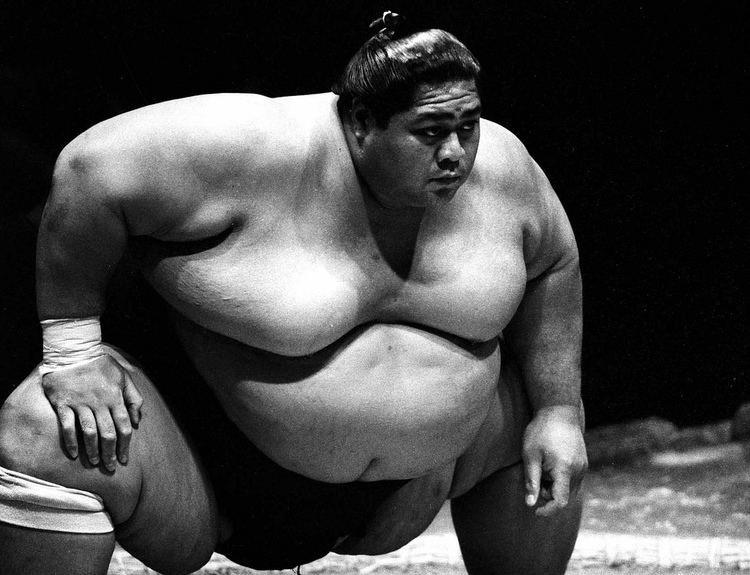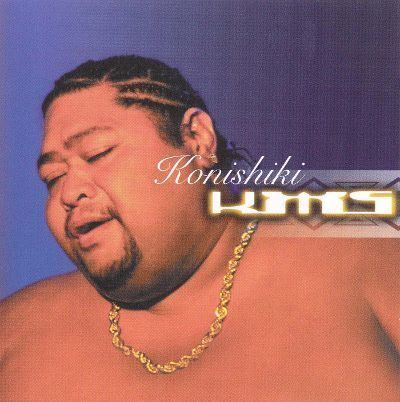Height 1.84 m (6 ft ⁄2 in) Highest rank Ozeki (July, 1987) Name Konishiki Yasokichi | Record 733–498–95 Debut July, 1982 | |
 | ||
Weight 287 kg (633 lb; 45.2 st)(maximum career. has since lost significant part of that) Spouse Chie Iijima (m. 2004), Sumika Shioda (m. 1992–2000) Similar Akinoshu Kenji, Kitanoumi Toshimitsu, Akinoshima Katsumi | ||
Konishiki Yasokichi & Chie Lijima
Konishiki Yasokichi (小錦八十吉, Konishiki Yasokichi, born Saleva'a Fuauli Atisano'e; December 31, 1963) is a Hawaiian-born Japanese-Samoan former sumo wrestler. He was the first non-Japanese-born wrestler to reach ōzeki, the second-highest rank in the sport. During his career he won the top division championship on three occasions and came close to becoming the first foreign-born grand champion, or yokozuna, prompting a debate as to whether a foreigner could have the necessary cultural understanding to be acceptable in sumo's ultimate rank. At a peak weight of 287 kg (633 lb) he was also the heaviest rikishi ever in sumo, earning him the nicknames "Meat Bomb" and "Dump Truck".
Contents
- Konishiki Yasokichi Chie Lijima
- The Story Behind this Iconic Photo in Sumo
- Early career
- zeki
- Close to yokozuna
- Later career
- Fighting style
- Life after sumo
- References
The Story Behind this Iconic Photo in Sumo
Early career
Atisano'e entered sumo in July 1982 at the age of 18, recruited by another Hawaiian-born wrestler, Takamiyama of the Takasago stable. A promising student at the University High School in Honolulu, he initially wanted to be a lawyer and was also offered a music scholarship to Syracuse University. His father had regular work with the US Navy but had to support eight children. Atisano'e regarded Takamiyama as a local hero and found the opportunity to join sumo too hard to resist.

Due to his potential he was given the name Konishiki, after the 17th Yokozuna, Konishiki Yasokichi I (see List of yokozuna) who came from the same training Stable at the end of the 19th Century (during the Meiji period in Japan) and Konishiki Yasokichi II (a komusubi in the beginning of the 20th century). Atisano'e was the sixth "Konishiki" in history, though he was the third to reach the top division. He rose to the privileged sekitori ranks in just eight tournaments, a remarkably rapid rise.

He made his debut in the top makuuchi division in July 1984, and in the following tournament in September he defeated two yokozuna, Chiyonofuji and Takanosato, and was runner-up with a 12–3 record. He was promoted to komusubi for the first time in May 1985 and sekiwake in July 1985. However, he suffered an injury to his coccyx (caused by a stool collapsing underneath him) and had to sit out all the next tournament. In May 1986 he suffered another injury, this time in competition, during a bout with Futahaguro. Konishiki came back strongly from this setback and three consecutive double figure scores in 1987 earned him promotion to ōzeki.
Ōzeki
Many people expected Konishiki to quickly make his push for yokozuna promotion. His stablemaster, the 46th Yokozuna Asashio Tarō III had predicted Konishiki would reach the top rank by his 25th birthday. However, his increasing weight caused a strain on his knee, exacerbated by previous high-school football injuries, which badly affected his performances. After a string of mediocre 8–7 scores he turned in a disastrous 3–12 in September 1988. His problems continued in 1989 and a 5–10 mark in September left him in danger of demotion from ōzeki once again. He made a spectacular comeback in November 1989, taking his first tournament championship with a 14–1 record. He was the first foreigner to win a top division title since Takamiyama in 1972. In March 1990 he took part in a three-way playoff for the title but he was outshone by Asahifuji, who earned promotion to yokozuna in July. In May 1991 Konishiki won 14 consecutive bouts but was beaten in a playoff on the final day by Asahifuji.
Close to yokozuna
By late 1991 Konishiki was a strong yokozuna candidate. He had overcome his injuries and showed much more consistency. Yokozuna Chiyonofuji and Ōnokuni had both recently retired, and Asahifuji and Hokutoumi were struggling with illness and injury. Konishiki took advantage by winning two championships (his 2nd and 3rd overall) in November 1991 and March 1992, with a record in the last three tournaments of 38 wins and 7 losses. However, he was denied promotion to yokozuna, with the chairman of the Yokozuna Deliberation Committee, Hideo Ueda, announcing, "We wanted to make doubly sure that Konishiki is worthy to be a grand champion. Therefore, we decided to wait for another tournament." Another member of the committee, Noboru Kojima, said in an interview that Konishiki did not possess hinkaku, a word derived from hin meaning "grace, elegance and refinement." His remarks were given the headline, "We Don’t Need a Foreign Yokozuna" by a newspaper. The New York Times subsequently quoted Konishiki as saying, "If I were Japanese, I would be yokozuna already." The Japan Sumo Association demanded an apology. Konishiki held a press conference in which he tearfully denied making the remarks, insisting that one of his personal attendants had impersonated him, but the damage had been done. The media furor hampered his preparations for the forthcoming tournament which resulted in a mediocre 9–6 record. Konishiki never came close to promotion again.
Later career
Konishiki retained his ōzeki ranking for 39 tournaments over more than six years, but he eventually lost it in November 1993 after two consecutive losing records. However, he continued to compete in the top division as a maegashira for another four years. Now weighing over 600 pounds (270 kg), he was very susceptible to belt throws and slap downs by lighter and more agile opponents. Ironically, even though he enjoyed less success, he became progressively more popular with Japanese fans due to his continuous fighting spirit, distinctive bulk and amiable personality. In November 1997, he faced demotion to the second jūryō division and announced his retirement after 15 years in sumo. He had spent 81 consecutive tournaments in the top division and won 649 bouts there.
Fighting style
Early in his career, under the instruction of his first stablemaster, Konishiki was primarily oshi-sumo specialist, preferring pushing and thrusting techniques such as oshi-dashi and tsuki-dashi that would win the bout as quickly as possible. Following his knee problems in 1988 and 1989, his balance suffered and as his weight continued to increase he began to change his style, preferring to bide his time by grabbing the opponent's mawashi and rely on his huge weight advantage to wear them out. By 1992 he was winning virtually all his matches by yori-kiri (force out), and his lack of ability to change tack once he had been sidestepped was one of the concerns raised by the Yokozuna Deliberation Committee when he was up for promotion.
Life after sumo
Konishiki remained in the Japan Sumo Association as an elder for a short time under the name of Sanoyama, before branching out as a Japanese entertainer under the name "KONISHIKI" (the capitalization is an effort to reflect the association's requirement to write his name in the Roman alphabet, after prohibition of spelling it out in Japanese characters after his retirement from sumo).
In 2000 Shinichi Watanabe, director of Excel Saga and Puni Puni Poemy, created an anime series called Dotto! Koni-chan, in which Koni, the protagonist, is a fat kid who strongly resembles KONISHIKI. The series pays homage to KONISHIKI, who is well loved by many Japanese people.
In January 2004 he married his girlfriend of two years, former medical worker Chie Iijima. He had previously married former model Sumika Shioda in 1992, but they divorced amicably in December 2000.
In 2006, he played in the film "Check It Out, Yo" Chekeraccho!! and also made a short appearance in the movie The Fast and the Furious: Tokyo Drift.
In 2006, his image was erroneously used as Akebono's in that year's Guinness Book of World Records in which his Hawaiian compatriot was recognized for being the heaviest Yokozuna in history.
Until March 2007, he was the host of an NHK children's program called Nihongo de Asobo (にほんごであそぼ) which teaches children traditional and colloquial Japanese. He was replaced by Sanyō Kanda and for the next year had a minor role on the show; mostly clips from older episodes or filmed from Hawaii. He returned from his hiatus in April 2008.
Although he continued to DJ for his FM Yokohama show Kony Island, he took a hiatus from Japanese celebrity life for a year, returning to Hawaii to prepare for gastric bypass surgery. Although he did not have high blood pressure or any heart problems, he had not lost much weight since his retirement, and underwent the operation in February 2008. He announced on his website that the operation went smoothly and that he has since lost some 70 kg (150 lb). He returned to Japan in May 2008.
Following his career in sumo, Konishiki transitioned into the music industry, where he became known for his musical collaborations, including works with Rimi Natsukawa and L-Burna on the track 'Livin Like Kings'. His performances frequently feature a blend of English and Japanese in both singing and rapping. Additionally, Konishiki is skilled in playing the ukulele.
Following the 2011 earthquake, Konishiki has been a very active and high-profile fund-raiser for disaster relief in the stricken regions of Japan.
He started the Konishiki Kids Foundation to help underprivileged children from Hawaii to experience Japanese culture.
